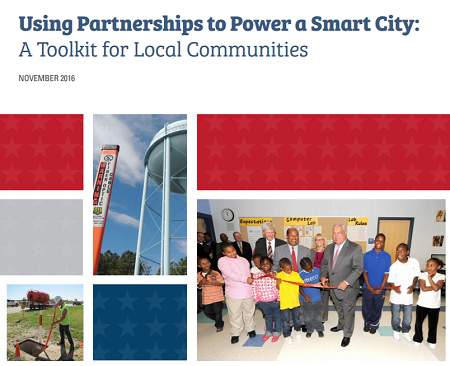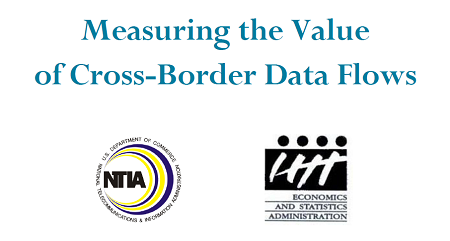NTIA Blog
Sizing up Spectrum Sharing Prospects
NTIA today is announcing the development of another tool to help meet the surging demand for spectrum from industry and government agencies. It also is the latest demonstration of the Obama Administration’s ongoing commitment to make spectrum available for wireless broadband.
As directed by President Obama in a 2013 Memorandum, NTIA is releasing the Quantitative Assessments of Spectrum Usage that summarizes our initial efforts to evaluate a range of federal spectrum bands for possible sharing with commercial users. These efforts will provide a basis for further detailed studies of potential sharing scenarios.
Using Partnerships to Power Smart Cities: A Toolkit for Local Communities
Many cities and local communities are eyeing advances in technology as a way to increase efficiency, reduce costs, and improve quality of life for their residents – all in the face of shrinking budgets. They are seeking to become “Smart Cities” by embedding new digital technologies into municipal infrastructure. The possibilities seem endless: smart grids, intelligent transportation systems, connected street lighting, and remote healthcare to name a few.
Although smart-city infrastructure is the foundation for vibrant societies of tomorrow, today many communities do not have the required expertise to develop and sustain new large-scale infrastructure and technology projects. Many also lack the funds needed for such investments. One way to meet these challenges is to harness the resources and strengths of private-sector stakeholders – innovators, businesses, community anchor institutions, educators, and more. Private-sector partners can be an important source of capital, technical knowledge, continuing innovation and workforce development.
Access to Broadband Fuels Workforce Development and Enhances Job Skills
This blog post was cross-posted on the Commerce Department's website.
Broadband has become an indispensable driver of economic growth and workforce development, creating new opportunities for Americans to participate in the modern, global economy and changing the way they find and do their jobs. Broadband provides channels for sharing information, learning new skills for career advancement, and completing basic job functions in a number of professions.
Understanding Spectrum Clutter—It’s Not About Neatness!
 Merriam-Webster defines clutter first as “a crowded or confused mass or collection,” and then as “interfering radar echoes caused by reflection from objects (as on the ground) other than the target.” As we work to make the most efficient use of the radio spectrum, including by sharing it, we need to better understand how radio spectrum interacts with real world environments, not just in a lab, in order to predict when and where interference might occur. Imagine painting rings around a particular source showing how far out the signal is likely to travel and cause possible interference to other sources – the better our understanding of how the spectrum operates in various environments the narrower the “brush” we can use to paint those lines. This means there will be less geography that must be protected against possible interference.
Merriam-Webster defines clutter first as “a crowded or confused mass or collection,” and then as “interfering radar echoes caused by reflection from objects (as on the ground) other than the target.” As we work to make the most efficient use of the radio spectrum, including by sharing it, we need to better understand how radio spectrum interacts with real world environments, not just in a lab, in order to predict when and where interference might occur. Imagine painting rings around a particular source showing how far out the signal is likely to travel and cause possible interference to other sources – the better our understanding of how the spectrum operates in various environments the narrower the “brush” we can use to paint those lines. This means there will be less geography that must be protected against possible interference.
One key issue that needs to be studied in more detail is “clutter,” which consists of environmental features such as buildings, other structures, and vegetation that cause signal loss due to scattering and absorption.
Mapping Computer and Internet Use by State: Introducing Data Explorer 2.0
Report Outlines Potential Improvements in Measuring Value of Data Flows
The Internet has extraordinary power to shrink the world -- to allow people separated by thousands of miles to more easily interact, learn from one another, and trade goods and services. These interactions are possible because of the incredible amounts of data that flows seamlessly across borders.
We know these data flows are happening and we know they are having an increasingly significant effect on the economy. However, solid statistical foundations for measuring the economic impact of cross-border data flows do not currently exist. What’s needed is the sound methodology and standard nomenclature that other economic data enjoy, so that policymakers can make informed decisions and businesses can choose strategies that will help them grow.
Late last year, the Commerce Department’s Digital Economy Leadership Team initiated a six-month effort to better understand data gaps related to measuring the economic value of the free flow of information across borders. This effort included meetings with over 30 stakeholder groups from the private and public sectors, a literature review, and a roundtable discussion convened on May 9, 2016, to discuss measurement gaps.
NTIA Shares Insights on Internet Research at TPRC
Digitally Unconnected in the U.S.: Who’s Not Online and Why?
What They're Saying: Why It's Important to Complete the IANA Stewardship Transition
In March 2014, NTIA initiated the final step in the privatization of the Internet’s domain name system (DNS) by asking ICANN to convene its global stakeholders to develop a plan to transition the stewardship role NTIA plays related to the DNS technical functions, known as the IANA functions. In June, NTIA announced that, after a thorough review, the transition proposal developed by Internet stakeholders meets the criteria we outlined aimed at maintaining the stability, security, and openness of the Internet that users across the globe depend on today.
In recent days, many Internet stakeholders have talked about the importance of completing the transition and the potential negative impacts of a delay. Here’s what they are saying:
NTIA, NSF Seek Comments to Shape National Broadband Research Agenda
Broadband is increasingly playing a central role in the lives of Americans. Job searches, education, entertainment, health care services, business ventures – those with access to reliable, high-speed broadband gain tremendous opportunities in almost every facet of life.
The Obama Administration has made expanding broadband access and adoption a top priority. While we have made good progress, more work needs to be done. In March 2015, President Obama established the Broadband Opportunity Council and tasked it with producing recommendations to increase broadband deployment, competition and adoption through executive actions.
In the Broadband Opportunity Council’s ensuing report, the National Telecommunications and Information Administration (NTIA) and the National Science Foundation (NSF) committed to developing a National Broadband Research Agenda to help shape the future of broadband by outlining a strategic plan for research into promising new technologies and applications, as well as promoting federal coordination in data collection practices and policies.


